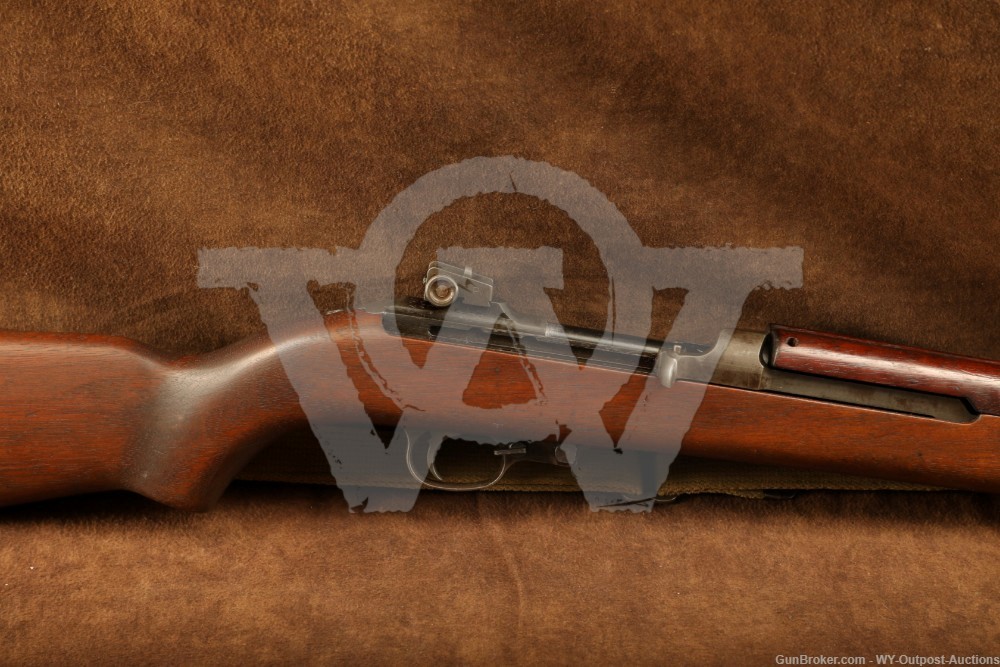
WWII Inland Division General Motors M1 Carbine .30 Cal 18” Rifle 1944
SOLD FOR: $1807
WOA#: WY230524IV003
Make: Inland Division of General Motors
Model: M1 Carbine
Serial Number: 5101767
Year of Manufacture: 1944
Caliber: .30 Cal Carbine
Action Type: Semi-Automatic
Markings: The top of the receiver is marked, “U.S. CARBINE CAL. 30 M1 / INLAND DIV. 5101767”. The barrel is marked “INLAND MFG. DIV. / GENERAL MOTORS / 4-44” with a “P” proof mark at the mid length. The bottom of the chamber has several proof marks. The bottom of the slide is marked “C”. The right side of the lower receiver’s leg is marked with an Inland Manufacture Stamp. The mag release is marked “M”. The right side of the rear sight is marked “P1”. The hammer is marked “H”. The right side of the buttstock is marked with an Inland Crossed Cannon Manufacturers Cartouche. The bottom of the grip is marked “RA-P” indicating that it has been rebuilt by Raritan Arsenal.
Barrel Length: 17.75″
Sights / Optics: The front sight is a fixed blade with protective ears. The rear sight is a late sliding adjustable aperture sight.
Stock Configuration & Condition: The stock is a Type III (low wood) M1 stock with a late Inland Buttplate, Type II upper handguard with narrow groove and 2 rivets, and Type III Barrel Band with bayonet lug. The safety lever is a later switch instead of the earlier crossbolt safety. The slide is a type V slide. The LOP measures about 13” from the front of the trigger to the back of the buttplate. The stock rates in about Fine condition. There are some compression marks, scratches, and nicks throughout. The stock has its cleaning kit.
Magazine Quantity & Condition: None.
Type of Finish: Blued, Parkerized
Finish Originality: Raritan Arsenal rebuild
Bore Condition: The bore is bright and the rifling is mostly sharp. There is little to no corrosion visible. The bore rates in Very Good condition.
Overall Condition: This rifle retains about 60% of its metal finish. The balance of the finish shows wear across the bolt group surface and around the receiver including some scratches on the barrel. The screw heads are sharp with some tooling evident on the barrel band screw head. The pins are unmarred. The markings are clear. There is oxidation and deep patina throughout. Overall, this rifle rates in about Very Good condition. Please see our photos for a better understanding of the rifle’s overall condition.
Mechanics: The action functions correctly. We did not fire this rifle. As with all used firearms, a thorough cleaning may be necessary to meet your maintenance requirements.
Box, Paperwork & Accessories: This rifle comes with its attached sling in Very Good condition. The snap is crisp and there is some staining on the canvas. There is little to no corrosion on the metal fittings.
Our Assessment: During the early stages of World War II, the U.S. military recognized the need for a lightweight rifle that would bridge the gap between the heavy and cumbersome M1 Garand rifle and the standard issue sidearm, the M1911 pistol. The goal was to provide troops with a compact and easy-to-handle firearm that offered more firepower than a pistol but was lighter and more maneuverable than a full-size rifle.
In 1941, the U.S. Army’s Ordnance Department contracted with various manufacturers, including Winchester, Inland, and General Motors’ Inland Division, to develop and produce the M1 Carbine. The rifle was designed by a team led by firearms designer David Williams, who drew inspiration from the successful M1 Garand and the short-recoil action of the M1 Thompson submachine gun.
The M1 Carbine featured a gas-operated, semi-automatic action and fired a .30 caliber cartridge known as the .30 Carbine. The cartridge, while less powerful than the standard .30-06 ammunition used in the M1 Garand, offered greater capacity and reduced recoil, making it more controllable and well-suited for short to medium-range engagements.
The M1 Carbine saw widespread use in World War II, becoming a staple firearm for American troops. It was praised for its reliability, ease of use, and versatility. The rifle was not only issued to U.S. forces but also provided to allied nations through various lend-lease programs.
After World War II, the M1 Carbine continued to serve in the Korean War and saw limited use in subsequent conflicts. It also became popular among civilian shooters and collectors due to its historical significance and manageable recoil.
Overall, the M1 Carbine played a significant role in U.S. military history, offering a lightweight and reliable firearm that filled a niche between pistols and full-size rifles. Its compact design, firepower, and ease of use made it a favored weapon among soldiers in various roles and contributed to its enduring legacy.
This rifle is an original General Motors Inland Division M1 carbine that dates to 1944 with matching stock and parts. It has been rebuilt after the war by Raritan Arsenal and is simply a beautiful rifle that will make a wonderful addition to any arsenal or WWII collection. Please see our photos and good luck!

